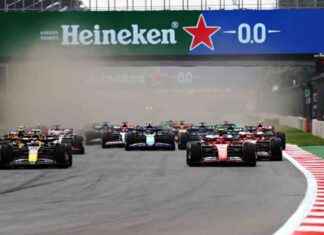Pope Francis arrived in Canada on Sunday for a “penitential pilgrimage” during which he is expected to renew his apologies for the role of the Church in the tragedy of residential schools for indigenous people, a gesture expected for years in the country.
• To read also: Papal visit: a craze difficult to predict
• Read also: Papal visit: air security tightened in the region
The pontiff, 85, landed late morning in Edmonton, western Canada for the first of three legs of his trip. He is expected to be greeted as he leaves the plane by Prime Minister Justin Trudeau and Inuit Mary Simon, the representative of Queen Elizabeth II.
He will also travel to Quebec and Iqaluit, the capital of the territory of Nunavut, a city in the Canadian Far North in the Arctic archipelago, before leaving on Friday.
Before leaving Rome, the pope tweeted a message to his “dear brothers and sisters in Canada”.
“I come among you to meet the indigenous peoples. I hope that, with the grace of God, my penitential pilgrimage can contribute to the path of reconciliation already undertaken. Please accompany me in prayer,” he wrote.
On the plane, he again insisted to the journalists on the penitential aspect of his trip, above all dedicated to the Aboriginal peoples, ancestral Amerindian peoples who today represent 5% of the population of Canada and who form three groups: the First Nations, Métis and Inuit.
The latter were subjected for decades to a policy of forced assimilation, in particular through a system of boarding schools for children, subsidized by the State, but administered for the most part by the Catholic Church.
Between the end of the 19th century and the 1990s, some 150,000 indigenous children were forcibly recruited into more than 130 of these institutions. They were cut off from their families, their language and their culture, and were often victims of violence. Up to 6,000 children lost their lives there.
Little by little, Canada is opening its eyes to this past described as “cultural genocide” by a national commission of inquiry: the discovery of more than 1,300 anonymous graves in 2021 near these boarding schools created a shock wave.
“This historic journey is an important part of the healing journey”, but “much remains to be done”, said George Arcand Jr, grand chief of the Confederacy of Treaty 6 First Nations, at a press conference on Thursday. in Edmonton.
The Argentinian Jesuit, who apologized to the Vatican last April in front of a delegation of Canadian natives, could also make symbolic gestures, for example by bringing back native works of art that have been kept in the Vatican for decades.
“Too late”
The city of Edmonton, to which many residential school survivors converged on Sunday, was preparing to welcome the sovereign pontiff, who had to use a platform lift to board his plane in a wheelchair. With more than ten hours of flight, this is the longest trip since 2019 for the Argentine pontiff.
After a day of rest on Sunday, François must meet for the first time with members of the indigenous peoples on Monday morning in Maskwacis, about a hundred kilometers south of Edmonton, where up to 15,000 people are expected. Alberta was the province with the largest number of residential schools.
“I would like a lot of people to come” to “hear that it is not invented”, confides to AFP Charlotte Roan, 44, resident of this poor community.
Others take a bitter look at the event. “For me, it’s a little too late because a lot of people have suffered,” laments near Saint-Paul (200 km east of Edmonton) Linda McGilvery, 68, who spent eight years of her childhood in a boarding school.
“I lost a lot of my culture, my ancestry, it’s a lot of years of loss”, regrets this woman from the Cree Nation of Saddle Lake who will “not make a detour” to see the pope.
Monday afternoon, the spiritual leader of the 1.3 billion Catholics is scheduled to deliver a second speech at the Church of the Sacred Heart of First Peoples in Edmonton. Tuesday, he must celebrate a mass in an Edmonton stadium where 65,000 people are expected, before going to Lac Sainte-Anne, site of an important annual pilgrimage.
In total, Francis is to deliver four speeches and four homilies, all in Spanish. He is the second pope to visit Canada, after John Paul II.







